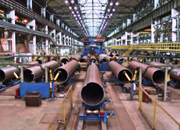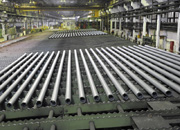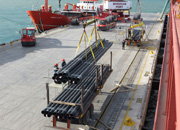First, the chemical composition of Q345DG and 16MnDG
low-temperature seamless steel pipes differs.
1. Basic composition of Q345DG low-temperature seamless steel pipe: Carbon ≤0.18%, Silicon 0.20-0.60%, Manganese 1.00-1.60%, Phosphorus ≤0.030%, Sulfur ≤0.030%.
Alloying elements: Trace amounts of niobium (0.015-0.06%), vanadium (0.02-0.15%), and aluminum (≥0.015%) are added to refine the grain size and improve toughness and strength.
Features: Through optimized alloying elements, the overall mechanical properties are superior, especially the low-temperature toughness, which is significantly improved.
2. 16MnDG Low-Temperature Seamless Steel Pipe Basic Composition: Carbon 0.12%-0.20%, Silicon 0.20%-0.55%, Manganese 1.20%-1.60%, Phosphorus ≤0.025%, Sulfur ≤0.015%.
Alloying Elements: May contain trace amounts of niobium, vanadium, titanium, etc., but the content is usually lower than that of Q345DG.
Characteristics: Manganese is the main strengthening element; low-temperature toughness depends on strict composition control, but overall performance is slightly inferior to Q345DG.
Second, Comparison of Low-Temperature Toughness between Q345DG and 16MnDG Low-Temperature Seamless Steel Pipes.
1. Q345DG Low-Temperature Seamless Steel Pipe
Low-Temperature Impact Performance: The design temperature is usually -20℃, but through controlled rolling and controlled cooling processes, the impact energy at -40℃ can reach over 27J, meeting the requirements of extreme environments.
Application Scenarios: Suitable for environments from -40℃ to normal temperature, such as pipelines in cold regions and low-temperature pressure vessels.
2. 16MnDG Low-Temperature Seamless Steel Pipe
Low-Temperature Impact Performance: Designed for temperatures ranging from -45℃ to -195℃, with an impact energy absorption of ≥34J at -40℃, exhibiting stronger resistance to low-temperature brittleness.
Application Scenarios: Liquefied natural gas (LNG), refrigeration equipment, ultra-low temperature heat exchangers, and other extreme low-temperature applications.
Third, Differences in Application Areas between Q345DG and 16MnDG Low-Temperature Seamless Steel Pipes.
1. Q345DG Low-Temperature Seamless Steel Pipe
Main Uses: High-load welded structural components such as ships, boilers, pressure vessels, bridges, and oil storage tanks, as well as chemical equipment and nuclear power pipelines.
Advantages: Excellent comprehensive mechanical properties, low-temperature toughness meets the requirements of conventional low-temperature environments, and relatively low cost.
2. 16MnDG Low-Temperature Seamless Steel Pipe
Main Uses: Liquefied natural gas (LNG) transmission pipelines, low-temperature pressure vessels, refrigeration equipment, aerospace, and other ultra-low temperature environments.
Advantages: Stable performance at extreme low temperatures, strong corrosion resistance, but higher cost.
Fourth, the differences in standards and specifications between Q345DG and 16MnDG low-temperature seamless steel pipes.
1. Q345DG Low-Temperature Seamless Steel Pipe
Standards: GB/T8162 (for structural use), GB5310 (for high-pressure boilers), GB5312 (for marine use), etc.
Features: Broad standard coverage, applicable to multiple fields, but low-temperature performance requirements vary depending on the standard.
2. 16MnDG Low-Temperature Seamless Steel Pipe
Standards: GB/T 18984 (Seamless steel pipes for low-temperature piping), ASTM A333 (international standard).
Features: Specifically designed for low-temperature environments, with extremely strict requirements on chemical composition, mechanical properties, dimensional tolerances, and surface quality to ensure safety under extreme conditions.
Fifth, Comprehensive Comparison and Summary:
Characteristics: Q345DG and 16MnDG exhibit excellent low-temperature toughness (-20℃ to -40℃) and outstanding performance at extreme low temperatures (-45℃ to -195℃). Chemical Composition: Contains trace amounts of Nb, V, and Al, with refined grains. High manganese content, possibly containing trace alloying elements. Application Areas: Conventional low-temperature environments, high-load structural components, cryogenic pipelines, LNG equipment, refrigeration systems. Standards and Specifications: Widely applicable across multiple fields. Designed specifically for cryogenic environments with stricter requirements. Relatively lower cost.
 Threeway Steel is known as a professional supplier engaged in manufacturing and distributing a wide range of steel pipe, and our headquarter located the central part of China – Hunan and six associated factories throughout China.
Threeway Steel is known as a professional supplier engaged in manufacturing and distributing a wide range of steel pipe, and our headquarter located the central part of China – Hunan and six associated factories throughout China.
 Threeway Steel is known as a professional supplier engaged in designing, manufacturing and distribution of a wide range of steel products with the headquarter located the central part of China – Hunan and six associated factories throughout China.
Threeway Steel is known as a professional supplier engaged in designing, manufacturing and distribution of a wide range of steel products with the headquarter located the central part of China – Hunan and six associated factories throughout China.
 Threeway Steel is known as a professional supplier engaged in designing, manufacturing and distribution of a wide range of steel products with the headquarter located the central part of China – Hunan and six associated factories throughout China.
Threeway Steel is known as a professional supplier engaged in designing, manufacturing and distribution of a wide range of steel products with the headquarter located the central part of China – Hunan and six associated factories throughout China.
 Threeway Steel is known as a professional supplier engaged in designing, manufacturing and distribution of a wide range of steel products with the headquarter located the central part of China – Hunan and six associated factories throughout China.
Threeway Steel is known as a professional supplier engaged in designing, manufacturing and distribution of a wide range of steel products with the headquarter located the central part of China – Hunan and six associated factories throughout China.
 Threeway Steel is known as a professional supplier engaged in designing, manufacturing and distribution of a wide range of steel products with the headquarter located the central part of China – Hunan and six associated factories throughout China.
Threeway Steel is known as a professional supplier engaged in designing, manufacturing and distribution of a wide range of steel products with the headquarter located the central part of China – Hunan and six associated factories throughout China.

